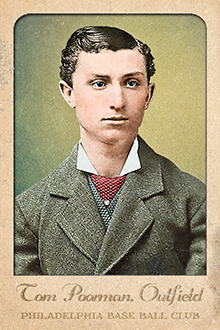
- Series: Pioneer Portraits II: 1875-1899
- City: Philadelphia
- Team: Athletics (AA)
- League: American Association
Thomas Iverson Poorman (1857-1905) was a pitcher/outfielder for five major-league teams from 1880-1888 with stints in the minors mixed in. His start in the pros was with the NL’s Buffalo Bisons, going the same season to the Chicago White Stockings. He played for the two New York entries in the Eastern Championship League in ‘81, the NY Metropolitans and New York New Yorks. He didn’t play the next year and went to Toledo in ‘83. The Blue Stockings advanced from the Northwestern League to the American Association in ‘84 so Tom got back to the big leagues. Poorman had brief turns with NL and AA clubs, leaving the Athletics for Western Assoc teams 1889-91. The lure of the diamond must have been strong as he made one last try with his hometown Lockhaven, PA Maroons after a five year absence from professional baseball, in 1897. He pitched in three of his ML campaigns, going 3-9 and had a career batting average of .244 in the majors.
- During his short time with the New Yorks, Tom played with future Hall of Famer Dan Brouthers
- Poorman might best be remembered today as the butt of a practical joke pulled off by the Goodwin editors on one of his four documented Old Judge cards. For pose 371-2, the Goodwin jokers make light of Tom's surname by identifying him as a "Poor Man."

- Series: Pioneer Portraits II: 1875-1899
- City: Philadelphia
- Team: Athletics (AA)
- League: American Association
Dennis Patrick Aloysius Lyons (1866-1929) was a strong hitting third-baseman over a thirteen year career in the major leagues from 1885 with Providence to 1897 with the Pirates. His lifetime batting average was .310. In 1890 he led the American Association in on-base percentage and slugging, and was second to Chicken Wolf in BA. He hit 62 home runs in the Deadball Era and was known as a formidable fielder in the no-glove era. Lyons’ era was also a time of rapid evolution in the game. In 1887, the year Denny “hit” safely in 52 straight, the pitcher’s box had been tightened and the pitcher’s delivery shortened to one step. Walks were also considered hits that year which has caused most modern students of the game to dismiss his “streak,” second only to Joltin’ Joe. But DiMaggio didn’t have to hit a fastball hurled from fifty feet. Only two of the 52 games was affected by walks but they were in the middle of the run. Despite such quibbles, Lyons was clearly a very accomplished player both offensively and afield.
- Consistently ranked among batting leaders in both leagues he starred in: AA and NL
- An Amos Rusie fastball broke two fingers and ended Denny’s ML tenure. He continued in the minors and hit .274 for the Beaumont Oil Gushers in 1903
- Series: Pioneer Portraits II: 1875-1899
- City: Philadelphia
- Team: Athletics (AA)
- League: American Association
Sargent Perry “Sadie” Houck (1856-1919) was a much-traveled shortstop, playing for seven teams over his eight year career. A native of Washington D. C., Houck debuted with the Boston Red Caps in 1879 and closed his playing days with the New York Metropolitans in 1887. Houck was among the first players to be blacklisted by the National League owners as management combined to assert its dominance over the then-unorganized players.
- Houck led the American Association in fielding percentage in 1884
- Houck’s salary as a Red Caps rookie was $600

- Series: Pioneer Portraits II: 1875-1899
- City: Philadelphia
- Team: Athletics (AA)
- League: American Association
Louis W. Bierbauer (1865-1926) was the treasure, buried then in the snows of Lake Erie, who gave his beloved Pittsburgh team its new name. Ned Hanlon was the privateer who braved the icy waters of Presque Isle in winter to sign the second-baseman away from the Athletics. This “piratical” act became so celebrated it gave the Alleghenys their permanent identity. Louie had done very well by the Athletics’s for his first four years in MLB. His year in the Players’ League with Ward’s Wonders was equally effective, causing the canny Hanlon to seize on Philadelphia’s lapse (they had not “reserved” Bierbauer). Lou rewarded his new club with six fine years at second base. Over his 13-year career, Lou would hit .267 with a .656 OPS. His performance stumbled a bit after joining the Pirates, but Bierbauer remained a strong hitter and defender through the 1896 season.
- Per Sporting Life in ’89: “Bierbauer is undoubtedly the king-pin second-baseman of the [American] Association”
- Ended his major league tenure in 1898 but continued in the minors. Lou managed the Canadian League’s St. Thomas Saints in 1915, his final year in pro ball



